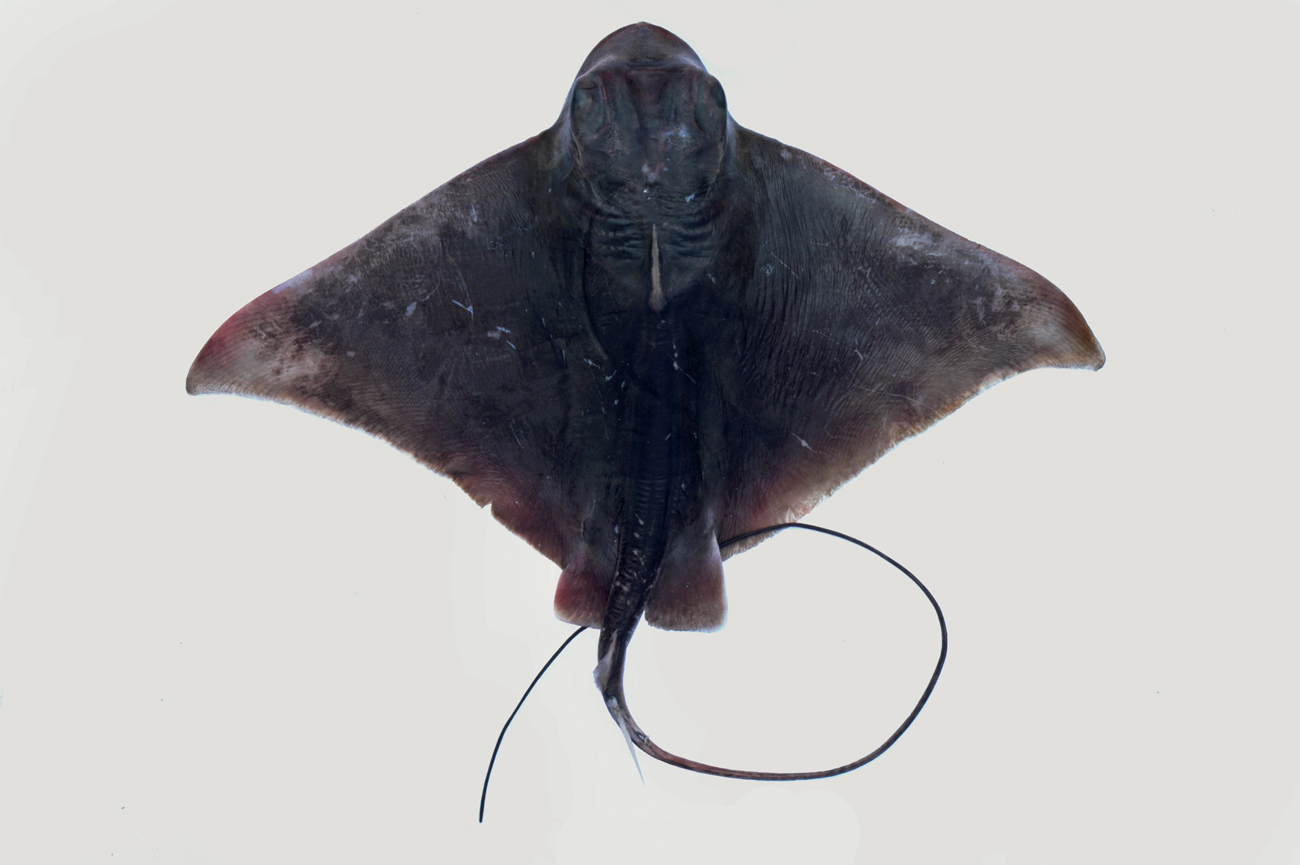Purple Eagle Ray, Myliobatis hamlyni Ogilby 1911
Other Names: Hamlyn's Bull-ray, Purple Bull-ray

A Purple Eagle Ray, Myliobatis hamlyni. Source: Ken Graham. License: All rights reserved
Summary:
A uniform purplish-brown or greenish-brown eagle ray with no spots or blotches, and a whitish underside.
Cite this page as:
Bray, D.J. 2023, Myliobatis hamlyni in Fishes of Australia, accessed 01 Jul 2025, https://fishesofaustralia.net.au/home/species/3546
Purple Eagle Ray, Myliobatis hamlyni Ogilby 1911
More Info
|
Distribution |
Scattered localities including Forestier Island and Shark Bay, Western Australia, and Swains Reefs, Queensland, to SE of Sydney, New South Wales; also the Norfolk Island region in the Tasman Sea. Elsewhere the species occurs in Indonesia, the Philippines, Taiwan, and southern Japan. Inhabits the outer continental shelf and upper continental slope at depths of 117-330 m. |
|
Features |
Disc diamond-shaped; pectoral fins very large, wing-like, leading edge straight to slightly convex. Whip-like tail slender with a distinctive fold along the ventral surface and 1-2 venomous spines at base. Seven rows of teeth in both jaws, central teeth the largest. |
|
Size |
Vertebral centra (total including synarcual) 114–119. Tail with a distinct, low ventral skin fold; 1-2 relatively long stinging spine, longest spine 13.1–15.9% DW; interorbital space moderately concave in adult males; anterior margins of pectoral fin straight to slightly convex; cranial fontanelle (visible in dorsal view without dissection) relatively wide with slightly convex lateral margins; claspers of adult males 5.5–5.7% DW; predorsal length 63.6–68.6% DW; pectoral-fin radials 85–92 (excluding rostral propterygial radials anterior of eyes). |
|
Biology |
Males mature at about 650 mm DW. Little is known of the biology of this species. |
|
Etymology |
The species is 'named for Ronald Hamlyn-Harris, Director of the Queensland Museum'. |
|
Species Citation |
Myliobatis hamlyni Ogilby 1911, Annals of the Queensland Museum 10: 40. Type locality: Moreton Bay, Queensland. |
|
Author |
Bray, D.J. 2023 |
|
Resources |
Purple Eagle Ray, Myliobatis hamlyni Ogilby 1911
References
Compagno, L.J.V. & Last, P.R. 1999. Families Gymnuridae, Myliobatidae, Rhinopteridae, Mobulidae. pp. 1505-1529 in Carpenter, K.E. & Niem, V.H. (eds). The Living Marine Resources of the Western Central Pacific. FAO Species Identification Guide for Fisheries Purposes. Rome : FAO Vol. 3 pp. 1397-2068.
Cox, G. & Francis, M. 1997. Sharks and Rays of New Zealand. Christchurch : Canterbury University 68 pp.
Duffy, C.A.J. 2015. Family Myliobatidae. pp. 201-204 in Roberts, C.D., Stewart, A.L. & Struthers, C.D. The Fishes of New Zealand. Wellington : Te Papa Press Vol. 2 pp. 1-576.
Francis, M. 1993. Checklist of the coastal fishes of Lord Howe, Norfolk, and Kermadec Islands, southwest Pacific Ocean. Pacific Science 47(2): 136-170 figs 1-2
Francis, M. 2001. Coastal Fishes of New Zealand. Auckland : Reed Publishing (NZ) 3rd edn, 103 pp.
Grant, E.M. 1975. Guide to Fishes. Brisbane : Queensland Government, Co-ordinator General’s Department 640 pp.
Hector, J. 1877. Notes on New Zealand ichthyology. Transactions of the New Zealand Institute 9: 465-469
Johnson, J.W. 2010. Fishes of the Moreton Bay Marine Park and adjacent continental shelf waters, Queensland, Australia. pp. 299-353 in Davie, P.J.F. & Phillips, J.A. Proceedings of the Thirteenth International Marine Biological Workshop, The Marine Fauna and Flora of Moreton Bay. Memoirs of the Queensland Museum 54(3)
Kyne, P.M., Johnson, J.W., Courtney, A.J. & Bennett, M.B. 2005. New biogeographical information on Queensland chrondrichthyans. Memoirs of the Queensland Museum 50(2): 321-327
Last, P.R. & Stevens, J.D. 1994. Sharks and Rays of Australia. Canberra : CSIRO Australia 513 pp. 84 pls.
Last, P.R. & Stevens, J.D. 2009. Sharks and Rays of Australia. Collingwood : CSIRO Publishing Australia 2, 550 pp.
Ogilby, J.D. 1911. Descriptions of new or insufficiently described fishes from Queensland waters. Annals of the Queensland Museum 10: 36-58 figs 5-6 See ref at BHL
White, W.T. 2014. A revised generic arrangement for the eagle ray family Myliobatidae, with definitions for the valid genera. Zootaxa 3860(2): 149–166. https://doi.org/10.11646/zootaxa.3860.2.3
Whitley, G.P. 1940. The Fishes of Australia. Part 1. The sharks, rays, devil-fish, and other primitive fishes of Australia and New Zealand. Sydney : Roy. Zool. Soc. N.S.W. 280 pp. 303 figs.

